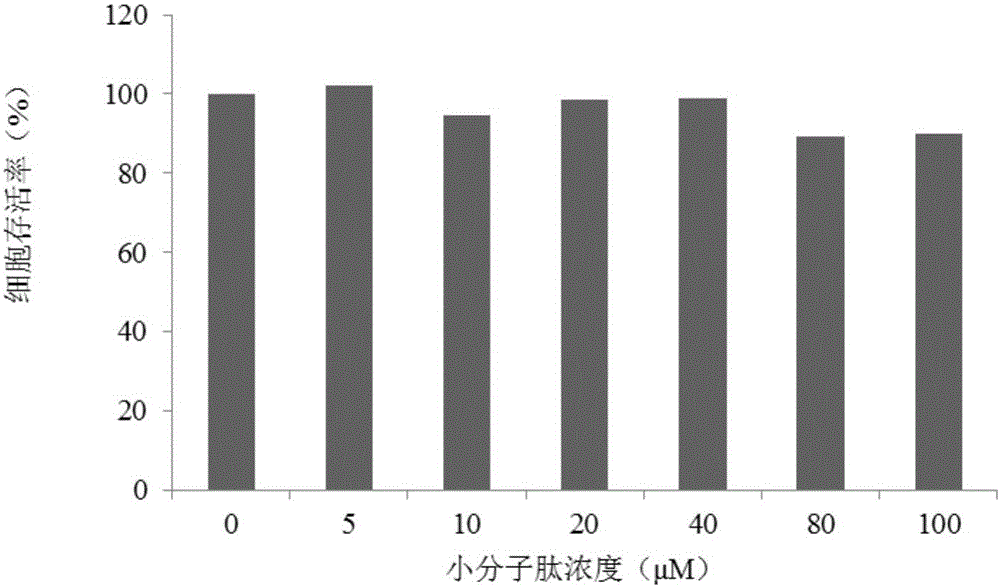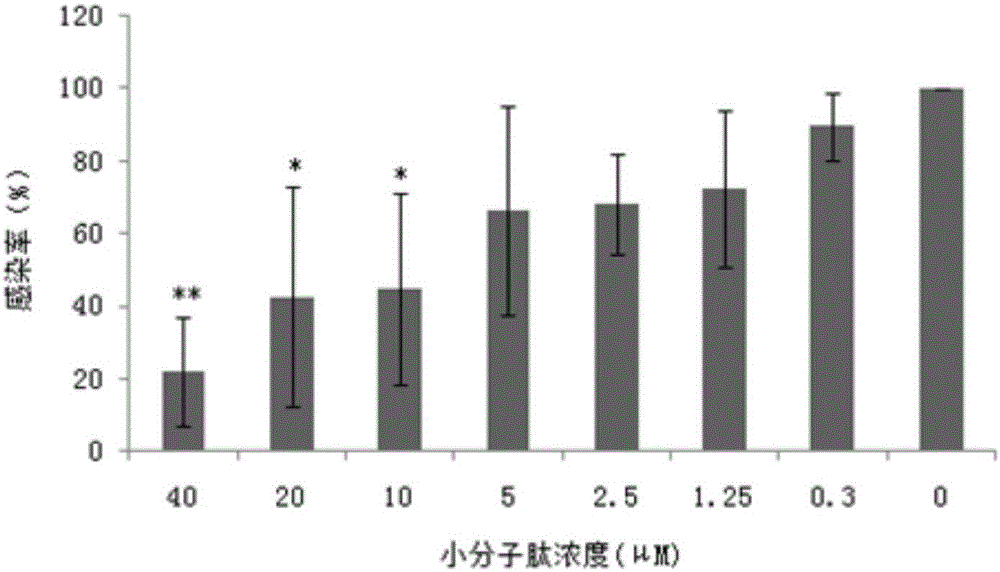Dengue virus E protein blocking peptide P4 and application thereof
A dengue virus and protein technology, applied in the direction of viral peptides, viruses, antiviral agents, etc., can solve the problem of no specific antiviral drugs, so as to inhibit dengue virus infection, reduce the infection rate, and reduce the risk of infection. effect of chance
- Summary
- Abstract
- Description
- Claims
- Application Information
AI Technical Summary
Problems solved by technology
Method used
Image
Examples
Embodiment 1
[0021] Example 1 Study on the Affinity of Small Molecular Peptide P4 and Dengue Virus Receptor Integrin β3
[0022] In this example, the SPR method was used to study the affinity between the small molecule peptide and the dengue virus receptor integrin β3. The small molecule peptide P4 was prepared into a solution with a certain concentration with phosphate buffer solution (PBS, pH7.4). Integrin ανβ3 (product number: RD3050-av-050) buffer was replaced with phosphate buffer and prepared to the desired concentration. The integrin ανβ3 was highly coupled to a CM5 chip (product number: GE29104988), and the small molecule peptide P4 was used as the mobile phase for affinity determination. BiacoreT200 was used for affinity analysis, and the results showed that the dissociation constant of small molecular peptide P4 and integrin β3 was 9.09E-5, indicating that it had a strong affinity with integrin β3 ( figure 1 ).
Embodiment 2
[0023] Example 2 Cytotoxicity Experiment of Small Molecular Peptide P4
[0024] In this example, MTT method was used to measure the cytotoxicity of small molecular peptides.
[0025] The small molecule peptide P4 was diluted with cell culture medium (DMEM containing 2% serum, 11965092, GIBCO) to prepare a solution with a certain concentration. MTT (3-(4,5)-dimethylthiahiazo(-z-y1)-3,5-di-phenyltetrazolium romide) was purchased from Sigma (product number: SIGMAM5655). The cells used were HUVECs (Human Umbilical Vein Endothelial Cells).
[0026] The specific steps are as follows: when the HUVEC cells grow to 80%-90%, the original medium is discarded and replaced with 200 μl per well of maintenance solution added with drugs. Both drugs have 6 gradients, namely 5μM, 10μM, 20μM, 40μM, 80μM and 100μM, 37℃5%CO 2 Cultivate for 24h. After 24 hours, discard the maintenance solution containing the drug and replace it with a maintenance solution containing 10% MTT, 200 μl per well, at...
Embodiment 3
[0027] Example 3 Inhibitory Experiment of Small Molecular Peptide P4 on Dengue Virus Infection
[0028] The small molecule peptide P4 was diluted with cell culture medium (DMEM containing 2% serum, 11965092, GIBCO) to prepare a solution with a certain concentration. The cells used were HUVECs (Human Umbilical Vein Endothelial Cells).
[0029] The specific steps are as follows: HUVEC cells were inoculated into a 48-well plate, about 5 × 10 per well. 4 cells. 37°C 5% CO 2 Cultivate for 16h. Discard the medium, wash once with PBS, dilute small peptides with 1640 medium containing 2% FBS, and dilute to gradients of 40 μM, 20 μM, 10 μM, 5 μM, 2.5 μM, 1.25 μM and 0.3 μM, respectively. 100 μl per well, set blank control and positive control, 37°C 5% CO 2 Cultivate for 2h. After 2 hours, add 10 μl of virus solution (MOI=2) to each well, at 37°C in 5% CO 2 Culture for 1h. After 1 hour, the supernatant and cells were collected (3M glycine was used to remove extracellular virus),...
PUM
 Login to View More
Login to View More Abstract
Description
Claims
Application Information
 Login to View More
Login to View More - R&D
- Intellectual Property
- Life Sciences
- Materials
- Tech Scout
- Unparalleled Data Quality
- Higher Quality Content
- 60% Fewer Hallucinations
Browse by: Latest US Patents, China's latest patents, Technical Efficacy Thesaurus, Application Domain, Technology Topic, Popular Technical Reports.
© 2025 PatSnap. All rights reserved.Legal|Privacy policy|Modern Slavery Act Transparency Statement|Sitemap|About US| Contact US: help@patsnap.com



